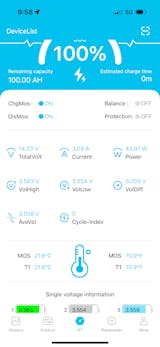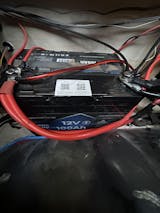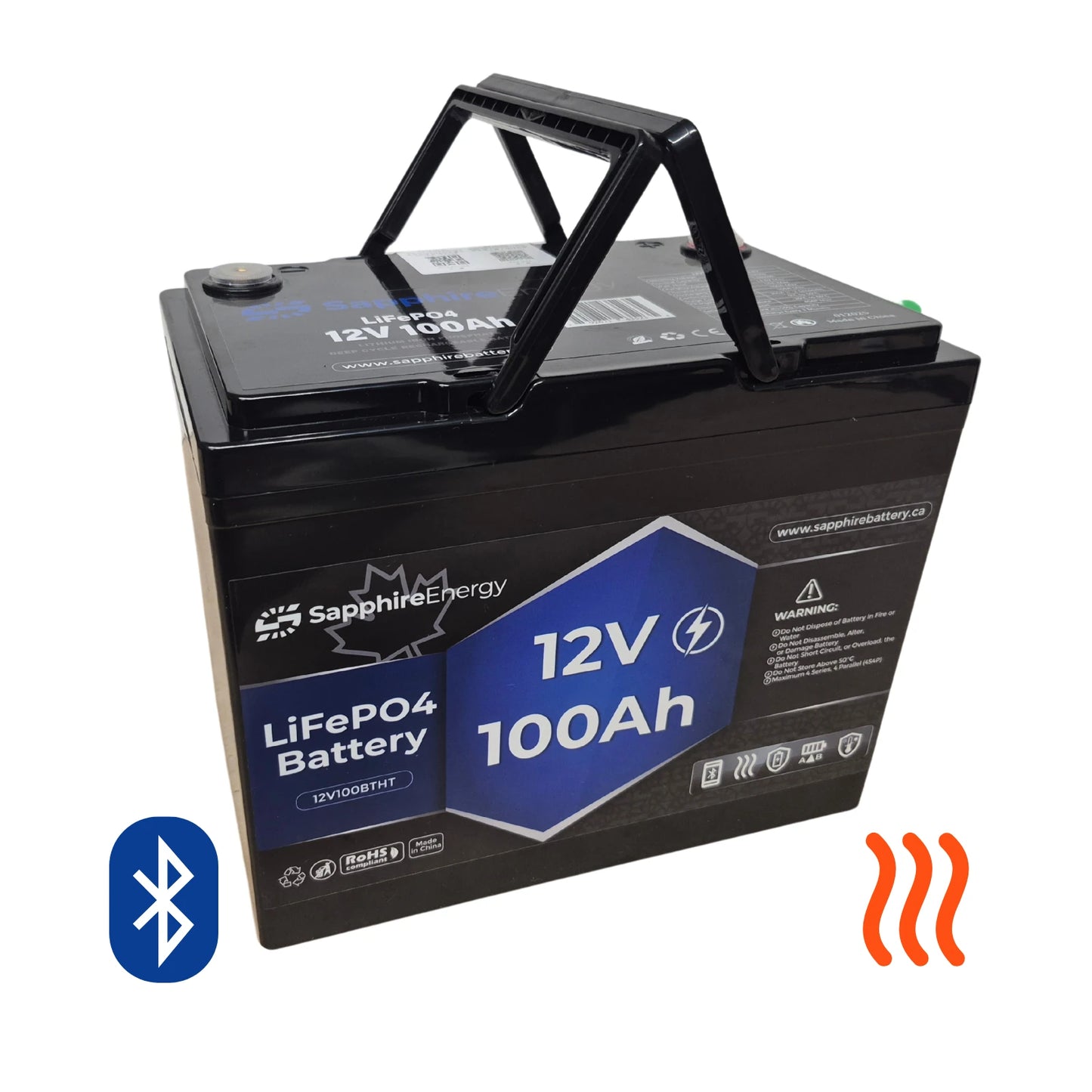
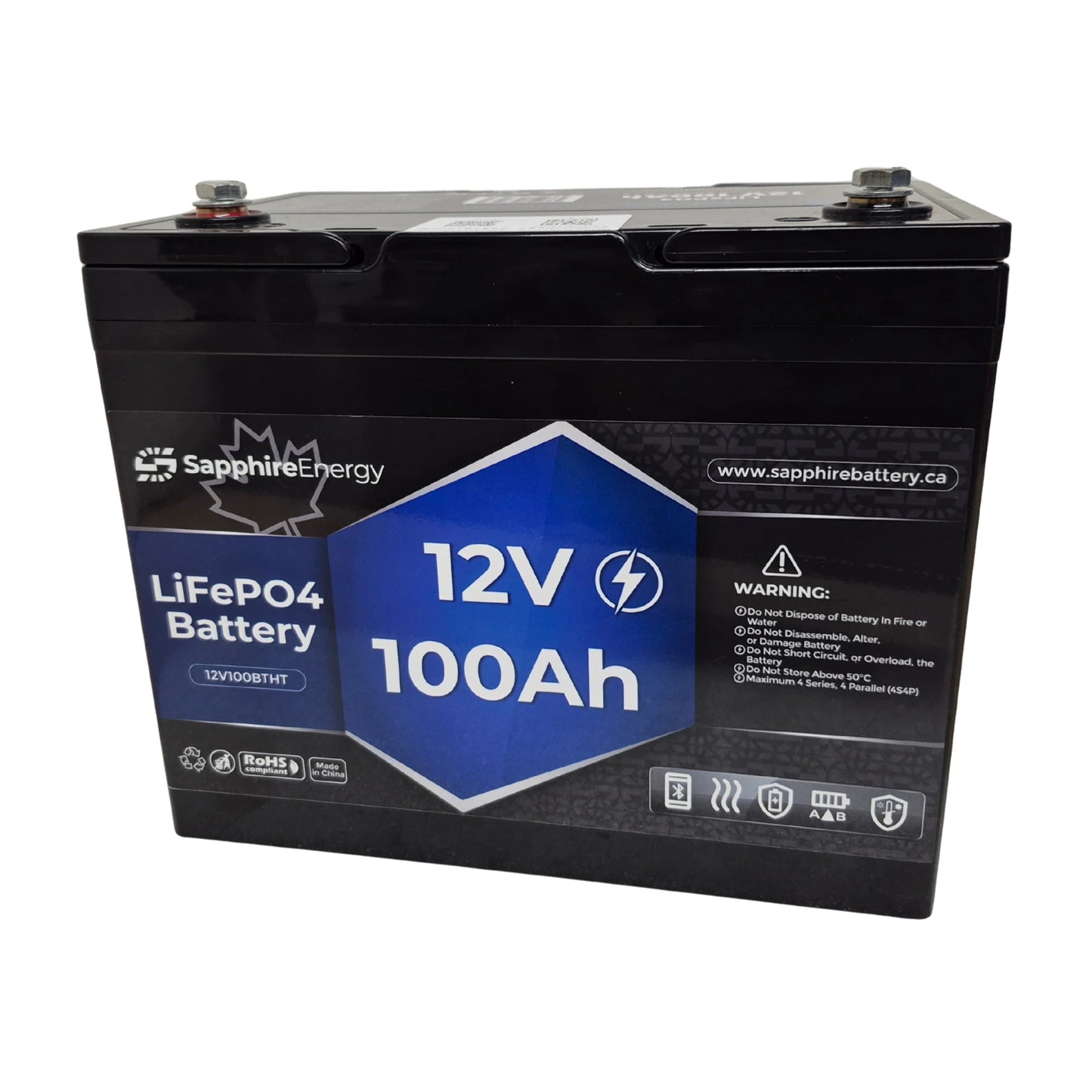
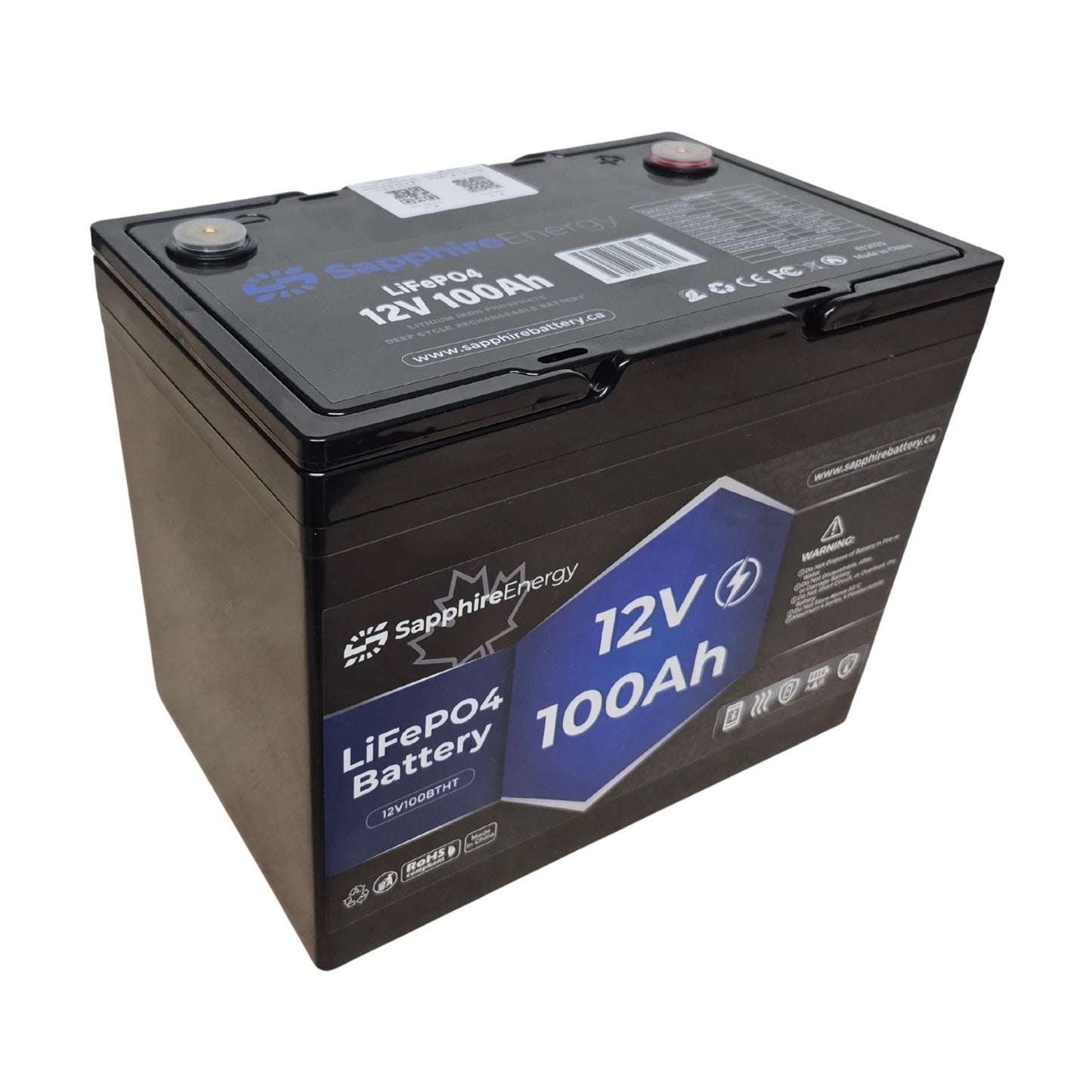
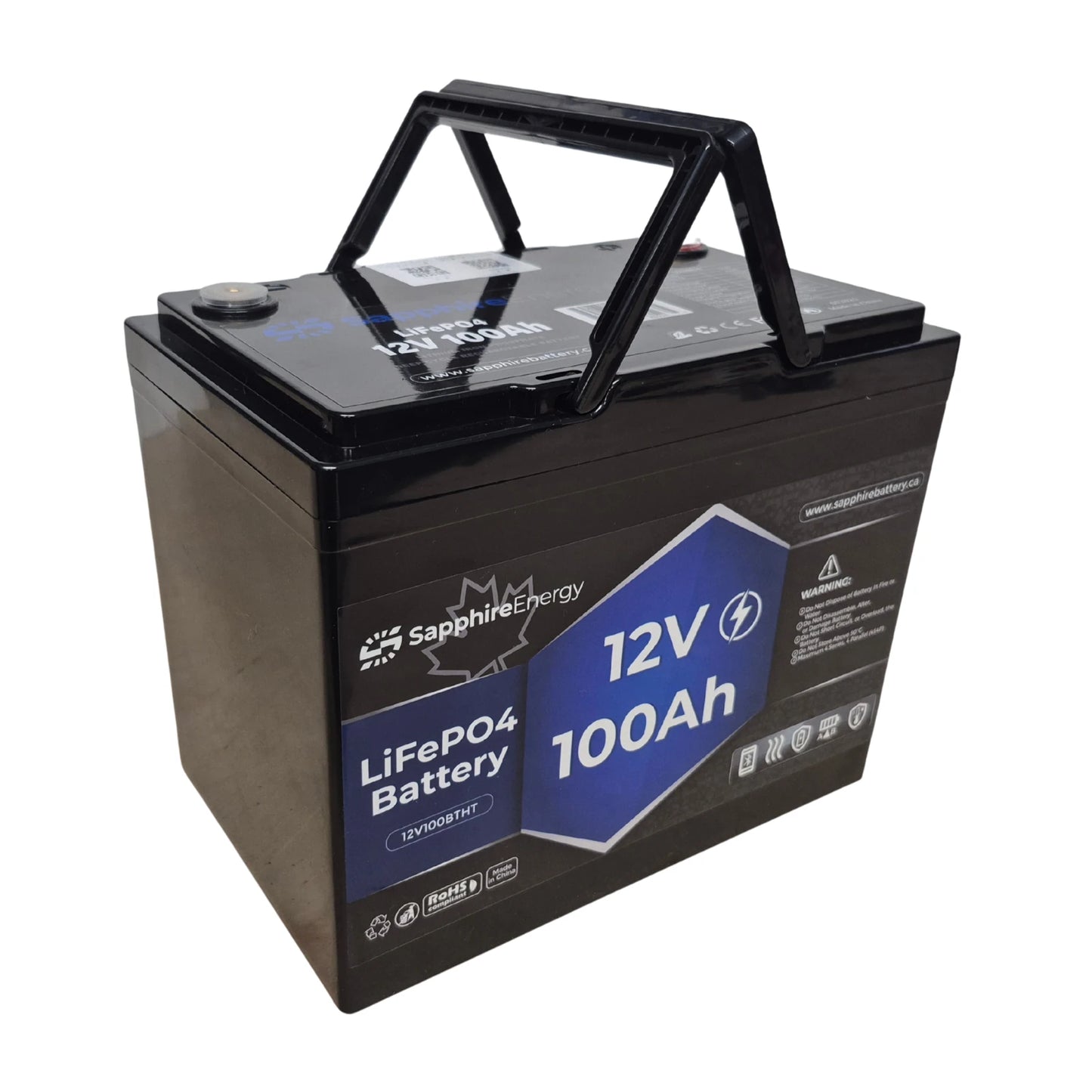
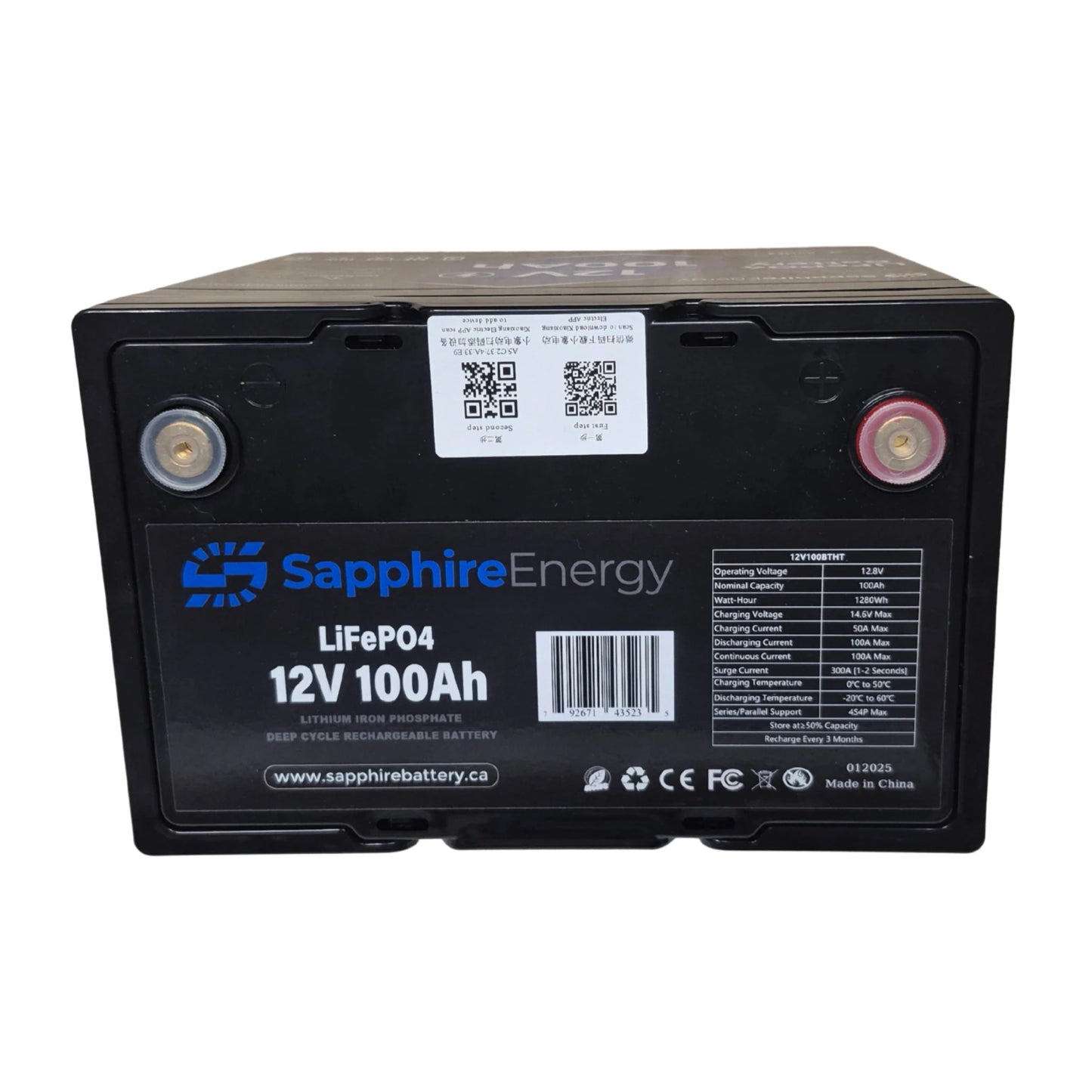
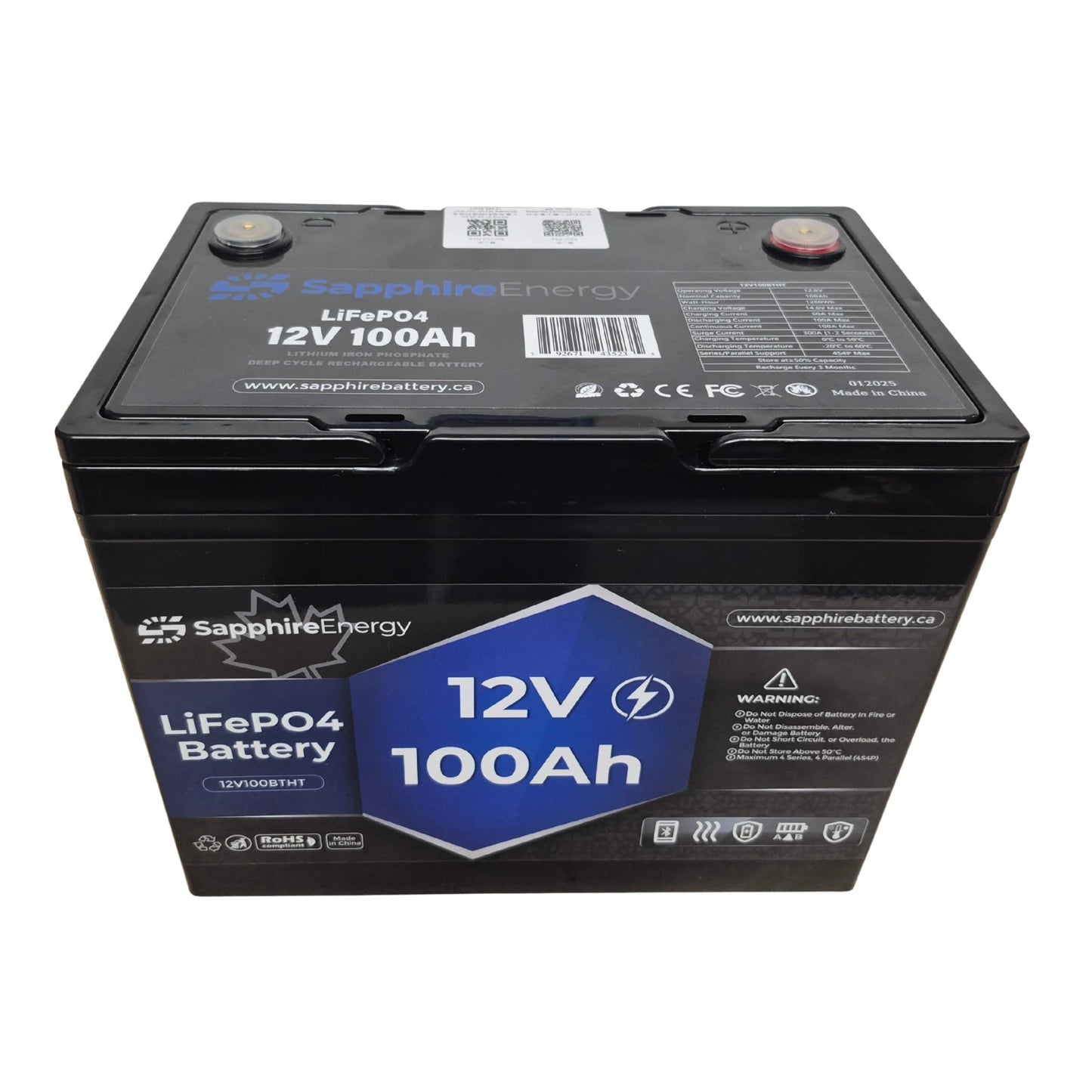
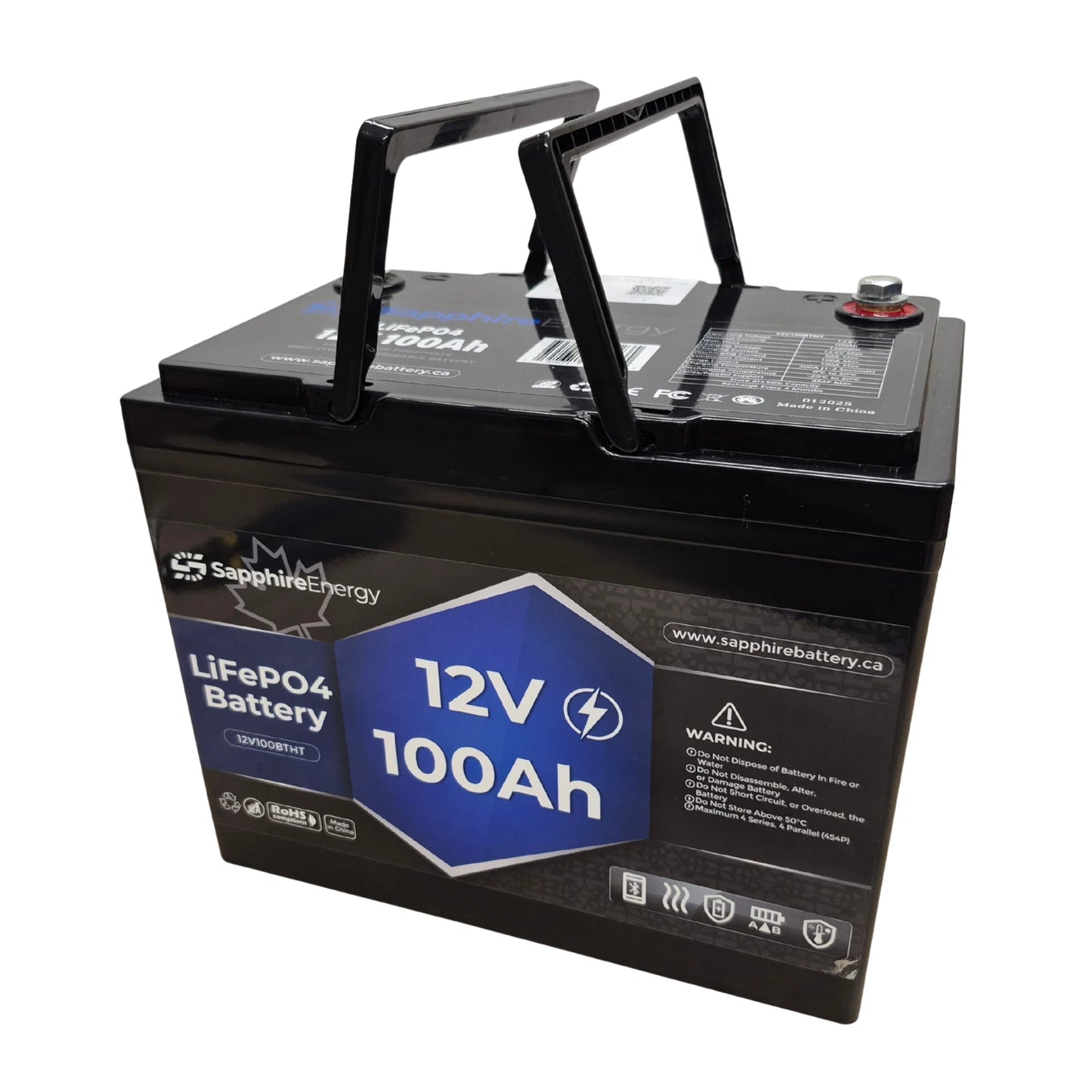
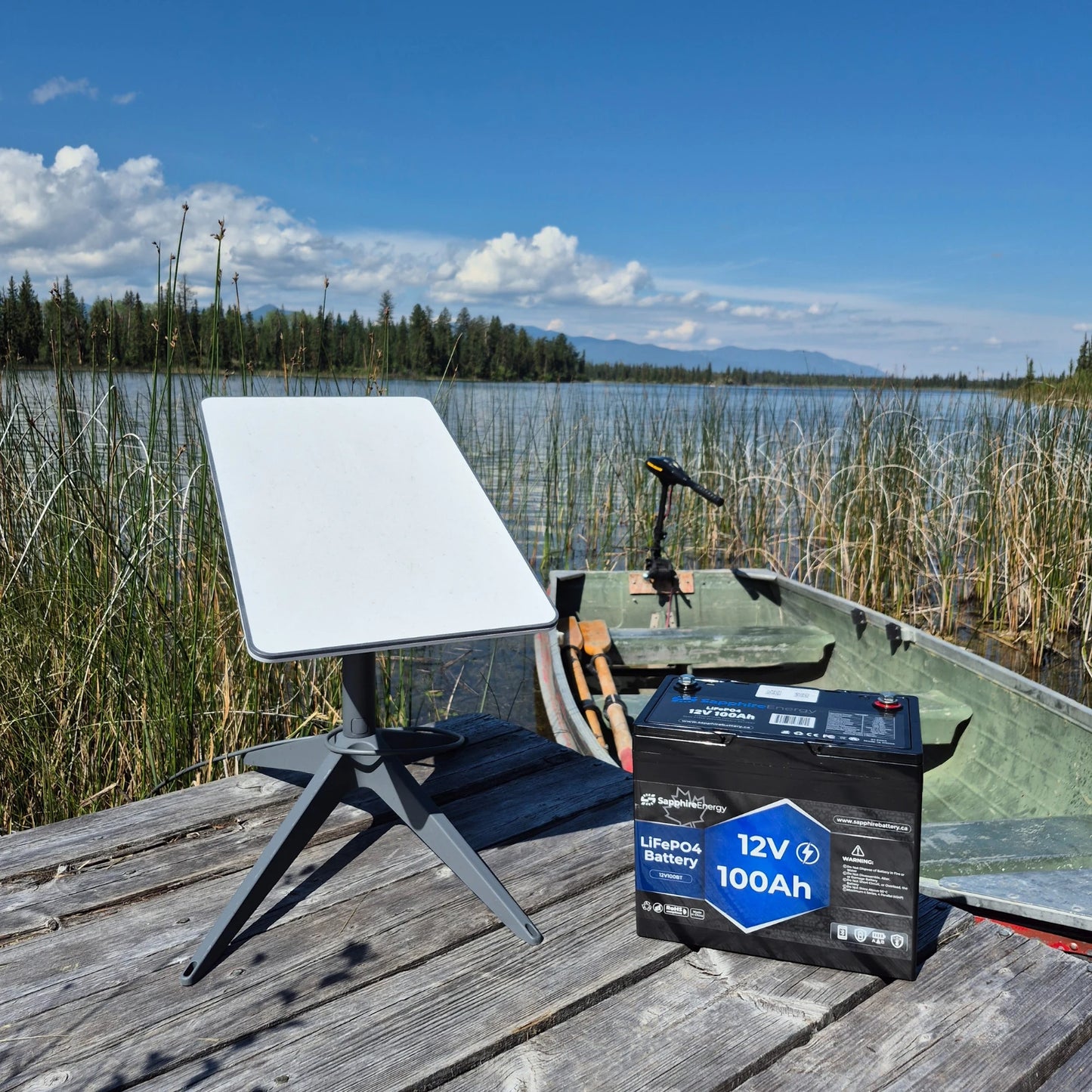

Why You'll Love It
| All-Season Power | Built-in 50 W self-heater warms cells to +5 °C before charging, enabling safe charging in sub-zero environments (down to −20 °C). | ||
| Bluetooth Control | Monitor SoC, voltage, current, temperature, cell balance, and alerts in real time via the mobile app (Bluetooth 5.0). | ||
| Portable Power | Only ~21 lb with ~1,280 Wh energy and 100 A continuous output—great for fridges, pumps, lighting, and compact installs. | ||
| Easy to Scale | Link up to 4 in series (48 V) or 4 in parallel for extended runtime—flexible growth path for your system. | ||
| Built to Last | A+ LiFePO₄ cells rated 5,000+ cycles (at typical DoD) with robust BMS protections; IP-rated enclosure for added durability. | ||
| Warranty & Support | Backed by a 5-year warranty and Canadian-based support for confidence on day one—and beyond. |
Reliable Power for Every Adventure
Go farther with confidence. The Sapphire Energy 12 V 100 Ah Self-Heating Bluetooth LiFePO₄ packs clean, stable power into a compact package that’s ready for RV life, marine weekends, off-grid cabins, and emergency backup. No fuss, no drama—just dependable energy whenever you need it.
Built around A+ grade LiFePO₄ cells and smart battery management, it delivers over 5,000 cycles at 80% DoD for years of use. LiFePO₄ chemistry is inherently safer and maintenance-free, so you can spend less time babysitting batteries and more time doing what you love.
Cold-Weather Charging Protection
Automatic self-heating system
Snow day? No problem. When temps drop, the integrated 50 W heater automatically warms the cells to a safe charging temperature (about +5 °C) before accepting charge. Your battery stays protected—and you keep rolling.
Enjoy reliable performance across the seasons with cold-weather charging safeguards and steady discharge down to −20 °C. Less worry, more adventure.
Compact Power, Big Capability
Runs all your 12 V essentials
Small footprint, serious punch. With 1280 Wh of stored energy and 100 A continuous output, run your fridge, lights, pumps, fans, and inverter without breaking a sweat. It’s a Group 24 drop-in that fits where others can’t—perfect for tight installs.
Less weight, more freedom. The durable case and easy-lift handles make installs and swaps a breeze, whether you’re dockside, trailside, or curbside.
Smart Bluetooth Monitoring
Real-time battery data at your fingertips
Know more, guess less. The Bluetooth 5.0 app shows state of charge, voltage, current, cell balance, temperatures, and more—so you can diagnose issues fast and optimize your setup on the fly.
Track trends over time to understand your consumption, right-size your solar or charging plan, and stretch more hours out of every adventure.
Expandable & Durable
Grow your system as your needs expand
Start with one, build as you go. Wire up to 4 in series for 48 V systems, or up to 4 in parallel for extended runtime. In a full 4S4P configuration, you’re looking at roughly 20.48 kWh of usable energy—big enough for serious off-grid living or whole-home backup.
Built to last with robust BMS protections and rugged construction, this pack is a future-proof upgrade you won’t outgrow anytime soon.
Advanced BMS Protection
Smarter safeguards for everyday reliability
The integrated Battery Management System continuously watches over voltage, current, and temperature so your battery stays safe and predictable in real-world use.
It provides protection against over-charge, over-discharge, over-current, and short circuit events, plus low-temperature charge cut-off and high-temperature disconnect to keep the cells in their happy zone. Cell balancing helps maintain performance and longevity across the pack.
If something goes out of spec, the BMS acts fast and resets when conditions return to normal—no tools or drama required.
The Sapphire Energy Advantage
Confidence you can count on. Every Sapphire battery is supported by a 5-year limited warranty and responsive, Canadian-based technical support. Our focus is on long-term reliability, safety, and a smooth ownership experience—before and after your purchase.
If you ever need help, you’ll reach a team that understands real-world mobile power and can guide you quickly and clearly.
Applications
- Recreational vehicles (RVs, motorhomes, campervans)
- Winter Recreation - Ice Fishing, Diesel Heaters
- Overlanding & Live-Aboard Van Conversions
- Marine Purposes (trolling motors, house batteries, depth sounders)
- Off-Grid Cabins
- Tiny Homes
- Solar & Wind Energy Systems
- Backup Power & Emergency Preparedness
- Mobile Workshops & Service Vehicles
- Golf carts and low-speed electric vehicles
Specifications
- High-performance A+ grade LiFePO₄ cells
- Advanced Battery Management System (BMS) with full protection
- Bluetooth 5.0 monitoring for real-time battery data
- Self-heating for cold-weather charging
- IP65 water and dust resistance
- 5-year limited warranty • 5000+ cycle life
| Model: | 12V100BTHT |
|---|---|
| Nominal Voltage | 12.8 V |
| Nominal Capacity | 100 Ah |
| Energy | 1280 Wh |
| Continuous Discharge | 100 A |
| Max Series / Parallel | 4S / 4P |
| Cycle Life | 5000+ cycles (80% capacity) |
| Ingress Rating | IP65 |
| Case Size | Group 24 (W/ Handles) |
| Dimensions (L×W×H) | 260 × 170 × 230 mm (10.25 × 6.7 × 9.1 in) |
| Weight | 9.6 kg (21 lb) |
| Warranty | 5-year limited |
Getting Started & Sizing
What size LiFePO₄ battery should I start with?
Easy first picks by use case:
• Budget/compact: 1280Wh — 12.8V 100Ah Classic
• More runtime: 2560Wh — 12.8V 200Ah Classic
• Winter & higher output: 2560Wh — 12.8V 200Ah Self-Heating Bluetooth (High Output)
• Longer runtime: 3840Wh — 12.8V 300Ah Bluetooth
New to sizing? How much battery do I need?
Can I replace my lead-acid battery one-for-one?
What inverter size pairs well with my first battery?
Why choose a single 24 V battery instead of 2×12 V in series?
• No pack-to-pack balancing — one case, one BMS, one Bluetooth connection.
• Simpler wiring — fewer cables, no series jumpers.
• Easier monitoring — one app (if Bluetooth).
• Lower current for the same power — slimmer cables and cooler-running inverters.
See our 24V 200Ah Self-Heating Bluetooth (High Output).
Charging: AC, Alternator & Solar
Do I need a charger made for LiFePO₄?
AC → DC charging (shore power or generator) — a dedicated LiFePO₄ charger converts household AC into a precise DC charge curve matched to lithium chemistry. If you’re plugging in at campgrounds, marinas, or with a small generator, this is the simplest route. Browse our LiFePO₄ Battery Chargers.
Solar charging — pair your panels with a solar charge controller that has a LiFePO₄ profile (or custom setpoints). The controller handles MPPT/PWM regulation and applies the correct voltages to protect the battery and maximize harvest. See our Solar Charge Controllers. If your controller offers user-defined setpoints, use the same 12 V targets above (bulk/absorb ~14.2–14.6 V; minimal/disabled float; no equalize).
Can I charge from my vehicle alternator?
Why Would I Need Self Heating?
Our Self-Heating batteries solve this by warming the cells automatically whenever charging is requested below freezing. The pack heats to a safe internal temperature, then begins charging—no manual steps. This is ideal for northern climates, winter activities (ice fishing, ski trips), vanlife, and outdoor storage where temps fluctuate. Adding insulation around the battery compartment helps it warm faster and reduces temperature swings for more consistent performance.
How much solar should I pair with a 12 V system?
Design rule of thumb (off-grid): 3 days of autonomy. That means sizing battery + solar so you can run for ~3 cloudy days without fully depleting the battery. If you also have alternate charging like a DC-DC alternator charger or occasional AC charger at campgrounds, you can safely reduce that autonomy target because you’re not relying on solar alone.
Step 1 — Calculate your daily watt-hours (Wh)
Make a list of devices: Watts × hours per day = Wh/day. Add them up.
Example day: LED lights (15 W × 4 h = 60 Wh), laptop (60 W × 3 h = 180 Wh), 12 V fridge (40 W avg × 24 h ≈ 960 Wh), phone charging (10 W × 2 h = 20 Wh). Total ≈ 1,220 Wh/day.
Step 2 — Size the battery bank
Battery capacity in Wh = Voltage × Ah. A 12 V 100 Ah LiFePO₄ ≈ 1,280 Wh, with ~80–90% usable = ~1,000–1,150 Wh usable. For 1,220 Wh/day and one day of autonomy, you’d look at ~12 V 200 Ah. For the full 3-day autonomy target, ~12 V 300–400 Ah (or a 24 V bank to reduce current).
Step 3 — Size the solar
Daily solar production ≈ Panel Watts × Sun-hours × system efficiency (efficiency often ~0.7 to include controller/battery losses). With 400 W of panels and 4 sun-hours: 400 × 4 × 0.7 ≈ 1,120 Wh/day—close to our 1,220 Wh example. If you drive daily with a DC-DC charger, you can rely on alternator charging to fill the gap and may choose fewer panels.
Be honest about heavy loads. High-draw devices (kettles, coffee makers, induction, space heaters) and large inverters increase both battery size and solar needed. Start small and expand as you confirm your real-world use.
For a deeper walkthrough, see How much battery do I need?, and explore Solar Products plus Charge Controllers.
Installation & Wiring
Can I connect multiple Sapphire batteries together?
Best practices: fully charge each battery before linking, use equal-length interconnects so currents share evenly, and match model/age/capacity. A Bluetooth model or a shunt monitor makes verification easy.
What wire size and fuse should I use?
Need parts? See Wiring & Accessories. For manuals and inverter/charger specs, visit Downloads.
Can I install my battery indoors?
Can I mount the battery on its side? Is the case weather-resistant?
Operation, Safety & Monitoring
Are Sapphire LiFePO₄ batteries safe?
How can I monitor health and state of charge (SOC)?
1) Shunt-based monitor (most accurate) — installs on battery negative and measures all current in/out to compute SOC, amps, Ah used, and time remaining. Our BM02 includes the shunt, an LCD, and a phone app. Wiring: battery negative → shunt → system negative, plus a small positive lead for the display.
2) Bluetooth batteries (fast & easy) — our Bluetooth packs report voltage, current, temperatures, cell balance, and BMS status in the app. A great example is the 12V 200Ah Self-Heating Bluetooth (High Output). Manuals and apps: Downloads.
Tip: Shunt monitors excel at accurate SOC over time; Bluetooth is great for diagnostics and cell-level detail.











